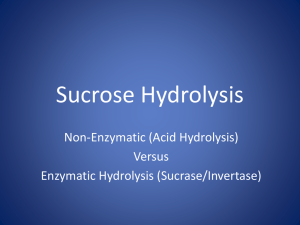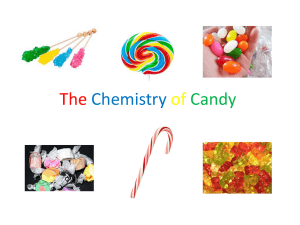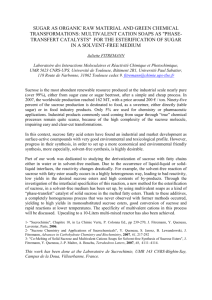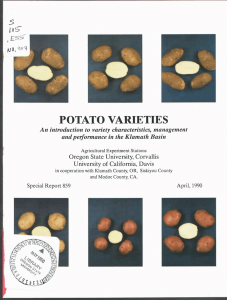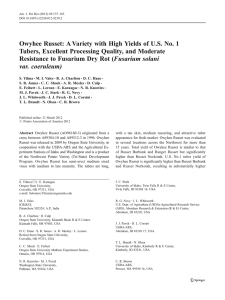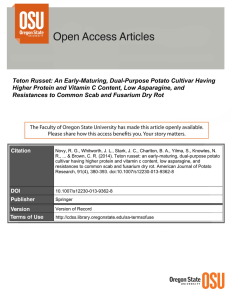How to minimize sugars
advertisement
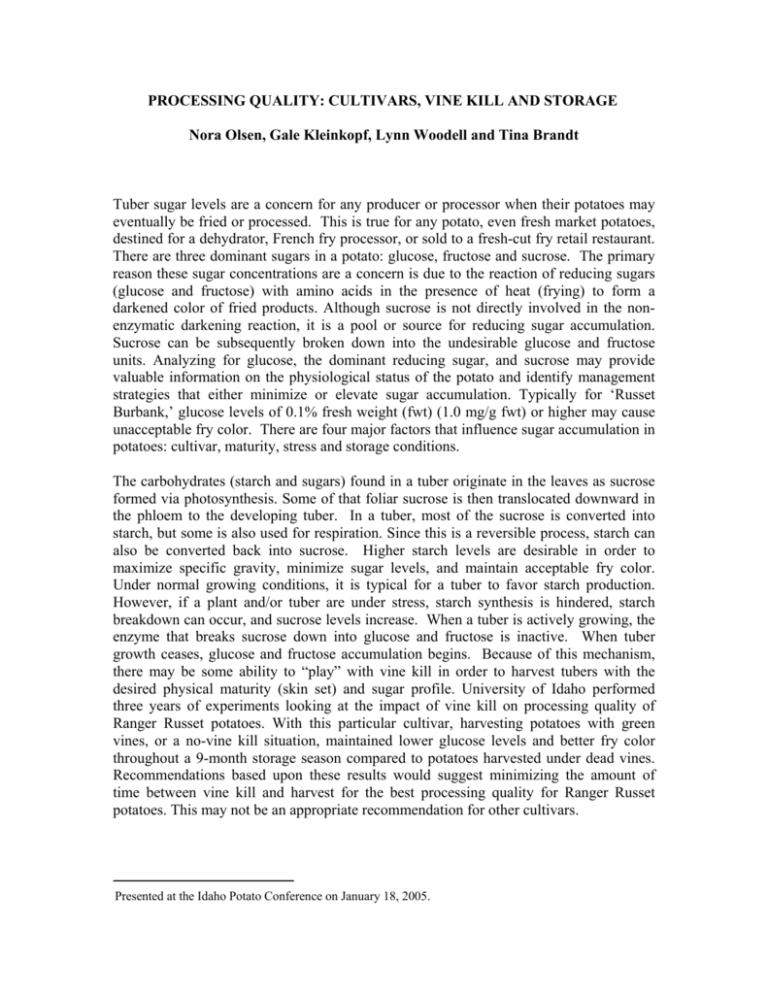
PROCESSING QUALITY: CULTIVARS, VINE KILL AND STORAGE Nora Olsen, Gale Kleinkopf, Lynn Woodell and Tina Brandt Tuber sugar levels are a concern for any producer or processor when their potatoes may eventually be fried or processed. This is true for any potato, even fresh market potatoes, destined for a dehydrator, French fry processor, or sold to a fresh-cut fry retail restaurant. There are three dominant sugars in a potato: glucose, fructose and sucrose. The primary reason these sugar concentrations are a concern is due to the reaction of reducing sugars (glucose and fructose) with amino acids in the presence of heat (frying) to form a darkened color of fried products. Although sucrose is not directly involved in the nonenzymatic darkening reaction, it is a pool or source for reducing sugar accumulation. Sucrose can be subsequently broken down into the undesirable glucose and fructose units. Analyzing for glucose, the dominant reducing sugar, and sucrose may provide valuable information on the physiological status of the potato and identify management strategies that either minimize or elevate sugar accumulation. Typically for ‘Russet Burbank,’ glucose levels of 0.1% fresh weight (fwt) (1.0 mg/g fwt) or higher may cause unacceptable fry color. There are four major factors that influence sugar accumulation in potatoes: cultivar, maturity, stress and storage conditions. The carbohydrates (starch and sugars) found in a tuber originate in the leaves as sucrose formed via photosynthesis. Some of that foliar sucrose is then translocated downward in the phloem to the developing tuber. In a tuber, most of the sucrose is converted into starch, but some is also used for respiration. Since this is a reversible process, starch can also be converted back into sucrose. Higher starch levels are desirable in order to maximize specific gravity, minimize sugar levels, and maintain acceptable fry color. Under normal growing conditions, it is typical for a tuber to favor starch production. However, if a plant and/or tuber are under stress, starch synthesis is hindered, starch breakdown can occur, and sucrose levels increase. When a tuber is actively growing, the enzyme that breaks sucrose down into glucose and fructose is inactive. When tuber growth ceases, glucose and fructose accumulation begins. Because of this mechanism, there may be some ability to “play” with vine kill in order to harvest tubers with the desired physical maturity (skin set) and sugar profile. University of Idaho performed three years of experiments looking at the impact of vine kill on processing quality of Ranger Russet potatoes. With this particular cultivar, harvesting potatoes with green vines, or a no-vine kill situation, maintained lower glucose levels and better fry color throughout a 9-month storage season compared to potatoes harvested under dead vines. Recommendations based upon these results would suggest minimizing the amount of time between vine kill and harvest for the best processing quality for Ranger Russet potatoes. This may not be an appropriate recommendation for other cultivars. Presented at the Idaho Potato Conference on January 18, 2005. CULTIVARS AND SUGAR MONITORING As previously mentioned, sucrose is not directly involved in the darkening color of fried potato products, but it is the source for glucose and fructose. In general, the higher the sucrose levels at harvest, the greater the potential for reducing sugar accumulation in storage. That is why it is important to evaluate sucrose levels at the beginning of the storage season and periodically throughout storage. Tuber maturity can influence sucrose levels. Immature potatoes can have higher sucrose concentrations because the plant is actively transporting sucrose to the tuber and the tuber is not able to metabolize the sucrose at the same rate. Once the potatoes are in storage, management decisions can impact processing quality. How the potato responds to the storage environment will be influenced by how the potatoes were grown and sugar levels at harvest. The major influences on processing quality in storage include: curing temperature, ramping rate, holding temperature, carbon dioxide concentrations, and duration in storage. Sprouting will also impact processing quality. In general, it is desirable to maintain sucrose levels below 0.15% (1.5 mg/kg fwt) for Russet Burbank. However, this sucrose level may not be a good indicator for all cultivars and can make cultivar comparisons difficult. For example, sugar data from one year showed at-harvest Russet Burbank and Ranger Russet sucrose levels (0.10%) as being very similar, and glucose levels were comparable in 48°F storage until approximately 175 days after harvest. At that point, Ranger Russet glucose concentrations elevated to unacceptable levels and Russet Burbank remained acceptable. On the other hand, Alturas had low sucrose levels at harvest (0.02%) and maintained low glucose levels throughout storage (0.03%). For a more extreme example, a numbered line, A93157-6LS, bred as a lower sugar accumulating potato, had very high sucrose levels (0.20%) at harvest, yet had almost nonexistent glucose levels during storage (0.02%). But overall, sucrose content can be useful to evaluate within a lot and between lots to determine reducing sugar accumulation potential. CULTIVARS AND STORAGE TEMPERATURES Cultivars differ in their starch, sucrose and reducing sugar accumulation. That accumulation will also depend upon temperature and storage conditions. In general, the lower the storage temperature, the greater the reducing sugar accumulation. Some cultivars can be stored at cooler temperatures and still have acceptable sugar levels and fry color. For instance, Russet Burbank and Umatilla Russet can be stored at 45°F and still maintain processing quality whereas Gem Russet and Ranger Russet need to be held at warmer temperatures (48°F) for acceptable frying quality. Although Russet Norkotah potatoes are not typically used to make fried products, they are utilized for dehydrated products and for fresh-cut fries. The lower specific gravity and tendency to rapidly accumulate reducing sugars in storage does not make it a quality cultivar for frying. Disregarding the texture and specific gravity issues, Russet Norkotah may have acceptable glucose levels at harvest appropriate for some processed products. Comparing Russet Norkotah to Russet Burbank at harvest and after several months in 45°F storage, the glucose accumulation is much greater with Russet Norkotah leading to unacceptable levels very quickly (Table 1). Also note the high sucrose level in Russet Norkotah potatoes at harvest. The glucose levels would also be much higher if the potatoes were stored cooler such as 42°F. Extremely high glucose levels are of concern for producing dehydrated products. Potatoes may be exposed to cold temperatures in the field or at inappropriate holding temperatures for the cultivar. A cultivar that is highly sensitive to cooler temperatures is Ranger Russet. Experiments where tubers were exposed to cold temperatures of 38°F for 0 to 6 days, or 45°F for 0 to 13 days directly after harvest and then stored at 48°F for the remainder of the season showed that even short periods of cold temperatures adversely affected quality. Ranger Russet potatoes exposed to 3 to 6 days at 38°F or 6 to 13 days at 45°F had darker fry color and higher glucose levels. These cold temperature exposures mimicked what a potato may be exposed to in the field prior to harvest. The results suggest minimizing Ranger Russet exposure to cold temperatures below 45°F. If potato sugar levels are unacceptably high, there is the possibility of reconditioning. The act or art of reconditioning consists of subjecting potatoes to high temperatures (5570°F) for 2 to 5 weeks to convert sugars back to starch and to respire off the unwanted sugars. This process is not always successful in the conversions and the issues of sprout development and rot potential at these higher temperatures are significant. SUMMARY High tuber-sugar levels contribute to the formation of a darkened fried product color primarily due to the reaction of reducing sugars (glucose and fructose) with amino acids in the presence of heat (frying). Another sugar, sucrose, does not react to form the darker color, but contributes to the production of reducing sugars. At-harvest evaluation of sucrose may give insight into maturity and potential reducing sugar accumulation in storage. Monitoring glucose levels in storage will identify when lots may produce unacceptable fry color levels. Cultivars differ in sugar content and lower storage temperatures will also increase sugar levels. Table. 1. Glucose and sucrose concentrations of Russet Norkotah and Russet Burbank potatoes at harvest and in storage at 45°F and treated with CIPC. Both cultivars were harvested under 2-week dead vines. Glucose (% fwt) Sucrose (% fwt) At harvest* March At harvest March Russet Norkotah 0.020 0.143 0.170 0.091 Russet Burbank 0.084 0.073 0.129 0.097 * Sept. 1 for R. Norkotah and Oct. 1 for R. Burbank

